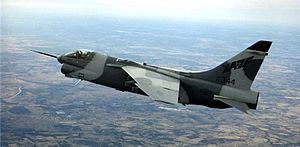First flight November 1989 | ||
 | ||
The Vought YA-7F "Strikefighter" was a prototype transonic attack aircraft based on the subsonic A-7 Corsair II. Two prototypes were converted from A-7Ds. The YA-7F was not ordered into production, its intended role being filled by the F-16 Fighting Falcon.
Contents
Design and development
In 1985, the USAF requested proposals for a fast strike aircraft because of concerns that A-10 Thunderbolt II was too slow for interdiction. The design called for a new engine, either the Pratt & Whitney F100-PW-220 or General Electric F110-GE 100. LTV responded with the YA-7F, a supersonic version of A-7 powered by an F100-PW-220 with 26,000 lbf (116 kN) thrust. To accommodate the new engine, the fuselage was lengthened about 4 ft (1.22 m). New fuselage sections were inserted in both the forward and aft fuselage - a 30 in (76 cm) section in front of the wing and an 18 in (46 cm) section behind the wing. The wing was strengthened and fitted with new augmented flaps, leading edge extensions and automatic maneuvering flaps.
The vertical stabilizer height was increased about 10 in (25 cm), the unit horizontal tail was flipped from dihedral to anhedral, and control surfaces were flattened. Unsurprisingly, the end result resembled the supersonic F-8 Crusader from which the original subsonic A-7 was derived. Many of the vehicle systems and mission systems were heavily modified and upgraded with leading edge technology, including a Molecular Sieve Oxygen Generating System and better cockpit displays. Low Altitude Night Attack Systems, an improved HUD and many software enhancements for navigation and weapons delivery were planned and being designed concurrently by Vought Dallas.
The new supersonic A-7 could accelerate with a 17,380 lb (7,880 kg) bomb load from 400 to 550 knots (1,020 km/h) in under 15 seconds and could sustain Mach 1.2 for longer times with the extra fuel. The YA-7F modifications allowed 7-g turn and burn capability that permitted high-speed sustained evasive maneuvers plus great improvements in high angle of attack performance. As a CAS/BAI platform to penetrate into enemy territory and return safely, the "Strikefighter" moniker was most fitting. Two A-7Ds were extensively modified, the first one flying on 29 November 1989, and breaking the sound barrier on its second flight. The second prototype flew on 3 April 1990.
The project was canceled due to improved relations with former adversaries, lower defense budgets, and the Air National Guard, by then the principal US operator of the A-7, generally favoring the in-production F-16 Fighting Falcon.
Variants
Operators
Aircraft on display
Specifications (YA-7F)
Data from Hill Aerospace Museum fact sheet
General characteristics
Performance
Armament
